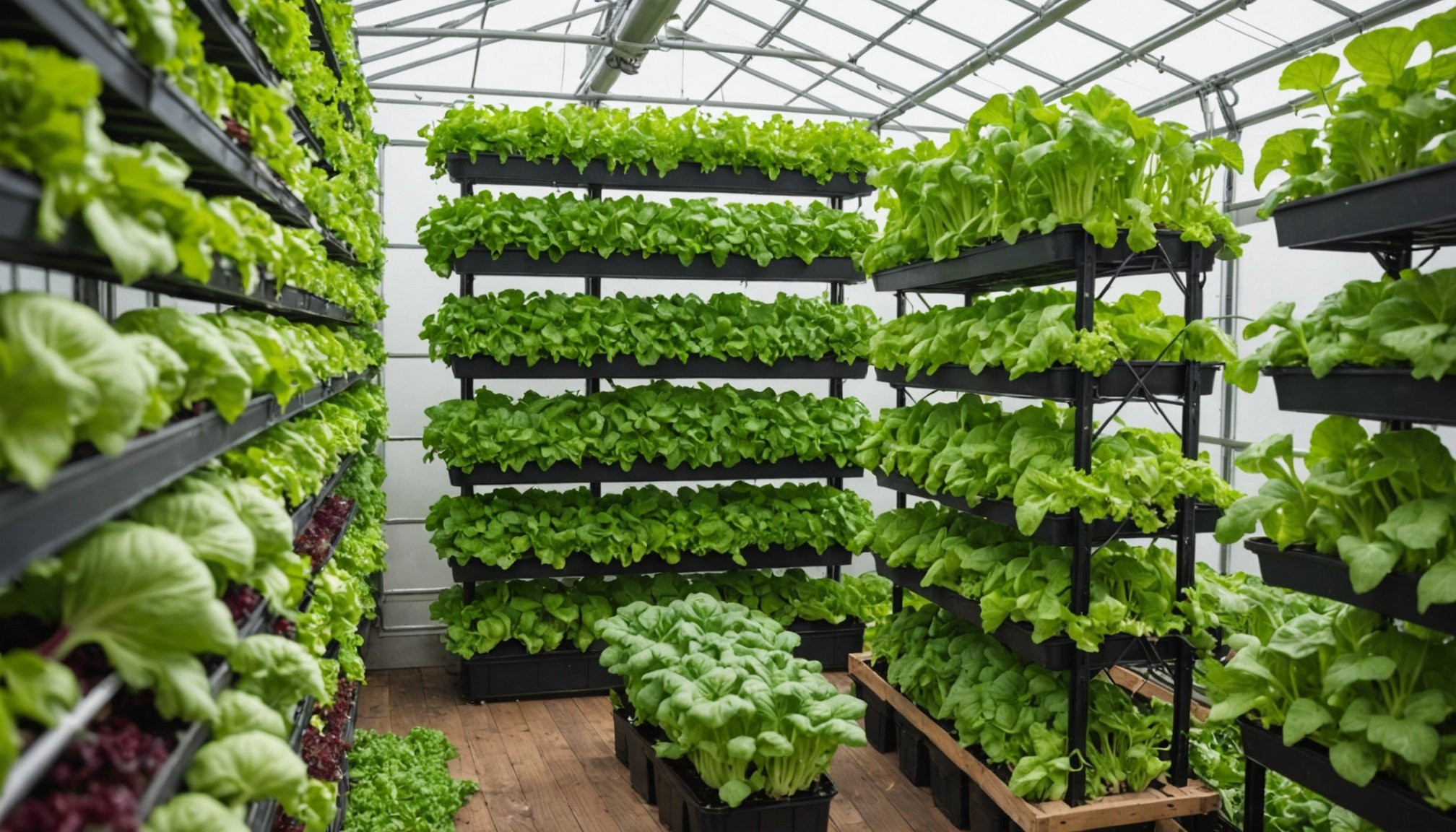Understanding Vertical Farming
Vertical farming is a transformative technique in sustainable agriculture. It allows for the cultivation of vegetables in vertically stacked layers, an innovative shift that makes the most of vertical spaces. This is particularly advantageous for urban areas with limited land availability, offering a sustainable solution for cities.
One of the primary benefits of vertical farming is its space efficiency. By growing crops in vertically stacked layers or integrated into other structures (like skyscrapers or shipping containers), urban dwellers and those with cramped outdoor spaces can enjoy the perks of year-round vegetable cultivation. Not only is it a boon for city residents, but it also contributes to reducing the carbon footprint associated with shipping agricultural produce over long distances.
Also to see : Transform Your Modern Loft: The Definitive Guide to Sustainable Wool Insulation
Moreover, vertical farming presents opportunities for home gardening, empowering individuals to manage a personal supply of fresh produce without needing expansive plots of land. This setup can support a diverse array of crops, ensuring that a broad spectrum of vegetables and herbs can be cultivated continuously throughout the year. Consequently, urban households can enjoy fresh, home-grown produce, enhancing both nutrition and food security.
Planning Your Vertical Garden
Designing a vertical garden requires careful consideration of various factors to ensure maximum growth and efficiency. Begin with planning your garden by evaluating the available space and determine the vertical height that can be utilised effectively. This step is crucial for selecting a suitable vertical garden design.
Additional reading : Transforming Senior Living with Easy Smart Home Tech: The Ultimate Guide to Seamless Integration
Location is key when planning. Ensure your garden receives ample sunlight, as most plants thrive with 6-8 hours of sunlight daily. Accessibility is equally important; choose a spot that allows effortless maintenance and harvesting.
The next step involves gathering essential materials and tools. This includes durable support structures, such as trellises or wall-mounted planters, which are integral to maintaining the layout’s integrity. Additionally, use high-quality potting soil enriched with nutrients specifically designed for vertical setups.
When considering your DIY vertical farm, prioritise lightweight and sustainable materials. Consider the strength of your chosen setup to support the weight of both plants and growing mediums. Adequate water drainage is vital, so incorporate design elements that facilitate water runoff and prevent pooling.
Implementing these strategies will result in a harmonious balance of aesthetics and practicality, ensuring your vertical garden flourishes.
Materials and Setup
Selecting the right vertical farming materials is vital for a successful setup. Begin by choosing robust support structures that can withstand weather conditions, especially if situated outdoors. Popular choices include metal frames, wooden pallets, or recycled materials for a sustainable approach.
Essential Materials
Essential materials for a vertical garden setup encompass pots or containers, nutrient-rich soil, and climbing supports if necessary. Opt for lightweight containers to ease the installation and maintenance process. Ensure your growing medium is tailored for vertical systems to provide adequate nutrition and stability.
Recommended Plant Containers
Selecting the proper plant containers is crucial to optimise space and growth. Consider using stackable or tiered planters that fit seamlessly into your space. Wall-mounted options can also maximise available room. Always choose containers with drainage holes to prevent water stagnation.
Irrigation Systems
For efficient water management, think about including automated irrigation systems. Drip irrigation is particularly effective in vertical gardens, delivering water straight to the roots and minimising waste. Ensure the system provides even coverage and can be adjusted seasonally to cater to changing plant needs. Proper drainage solutions are equally essential to protect from overwatering.
Plant Selection and Care
Choosing the right crops is crucial for vertical gardening success. Opt for vegetables and herbs like lettuce, spinach, and basil, which thrive in limited spaces and provide year-round yields. Consider plants with shallow root systems, as they require less soil and space, ideal for vertical setups.
When selecting seeds or seedlings, ensure they are disease-resistant and suited for your climate. Quality seeds are more likely to germinate successfully and produce robust plants. Planting should occur in nutrient-rich soil to promote healthy growth. Containers must offer proper drainage to prevent root rot, a common issue in confined spaces.
Providing adequate nutrients is paramount. Consider using a liquid fertiliser to supply essential minerals and vitamins directly to the roots. Regular monitoring and adjusting nutrient levels will keep your plants thriving.
Proper soil management is vital as it acts as the foundation for plant health. Ensure your soil retains moisture yet drains well to avoid waterlogging. Incorporate organic matter such as compost to enhance soil fertility, thereby supporting lush plant growth and vigorous vegetables. Frequent assessment of soil conditions will help maintain an optimal environment for your plants.
Maintenance and Troubleshooting
Proper vertical garden maintenance is critical for ensuring year-round thriving growth. Routine tasks involve checking the integrity of support structures and ensuring the irrigation systems function optimally. Regular cleaning prevents soil buildup and optimises water flow, whereas pruning helps manage plant growth and promotes air circulation.
To troubleshoot plant issues, start by identifying common pests and diseases. Aphids and powdery mildew often affect vertical gardens. Employ preventive measures like neem oil or insecticidal soap for treatment. For fungal issues, ensure proper airflow and avoid excess moisture.
Seasonal adjustments are crucial for adapting to temperature and light fluctuations. In colder months, consider using frost covers or moving sensitive plants indoors under grow lights. During hotter periods, provide shade and increase watering frequency to cope with elevated evaporation rates.
Adapting care strategies to suit changing conditions will safeguard plant health. Implement these garden care tips consistently to enjoy a robust and productive vertical garden. Remember, monitoring and timely interventions are key to overcoming challenges and maximising your garden’s potential.
Enhancing Your Vertical Garden Experience
Enlivening your vertical garden with thoughtful design and techniques can elevate both its productivity and aesthetic appeal. One effective method is companion planting, which involves growing complementary plants together to naturally enhance growth and deter pests. For instance, pairing basil with tomatoes not only boosts tomato flavour but also repels certain insects.
Incorporating creative aesthetic elements into your vertical garden can make it an enjoyable space. Consider using hanging pots, colourful planters, or trellises wrapped in fairy lights to infuse charm. These additions not only make your garden visually pleasing but can also increase personal engagement with your gardening activities.
To further boost productivity, apply yield maximization strategies. Employ techniques such as pruning to improve air circulation, or use mirrors to reflect light and increase sun exposure. Introducing nutrient-rich soil and practising regular crop rotation can sustain soil health, leading to robust growth.
Engaging with these practices not only enhances the beauty and efficiency of your vertical garden but also creates a fulfilling gardening experience. Embrace these strategies to transform your vertical setup into a thriving and captivating oasis.
Additional Resources and Next Steps
Enhancing your knowledge of vertical farming and connecting with others who share your interest can be extremely beneficial. To expand your understanding, consider exploring books that delve into sustainable agriculture principles. Online courses offer structured learning, providing in-depth insights into everything from vertical farming materials to crop management techniques.
Engaging with local gardening communities is invaluable. They can offer shared experiences and expert insights, allowing you to learn practical tips and troubleshooting techniques firsthand. Joining forums or local clubs can foster a sense of community, whilst connecting you with fellow enthusiasts who can offer advice on vertical garden setup and more.
Furthermore, documenting your vertical gardening journey can become a valuable resource not only for yourself but also for others. Sharing your successes and challenges with the community can inspire budding gardeners and contribute to a collective pool of knowledge. Encourage others to share their experiences and grow this community of shared learning. By embracing these resources and becoming part of a network, you’ll enrich your own gardening practice and help others along their DIY vertical farm journey.

